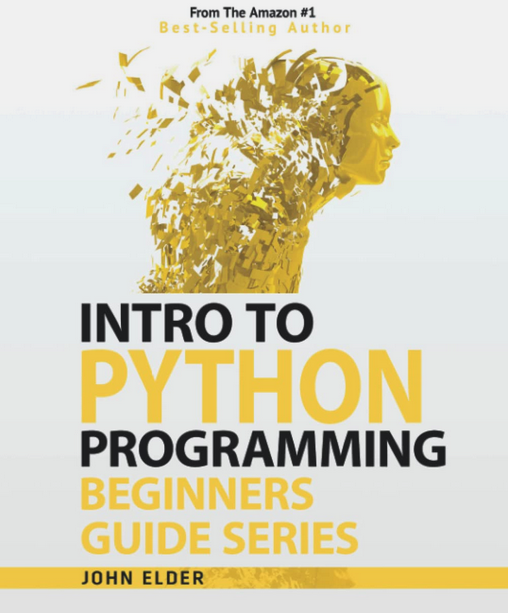Insights from Intro To Python Programming: Beginners Guide Series
As a parent and mentor, I’m always on the lookout for resources to inspire and educate young minds. My son recently expressed an interest in learning Python, and I also help kids at a coding club take their first steps into programming. These two motivations led me to John Elder’s Intro to Python Programming. This book promises to make coding approachable and fun for beginners, which aligns perfectly with my goals. Elder’s conversational tone and hands-on approach provide an excellent foundation for young learners and anyone embarking on their coding journey.

Summary
Chapter 1: Setting Up a Python Development Environment
Elder begins with the basics: setting up Python on different operating systems and selecting a text editor. He emphasises simplicity, recommending Sublime Text and Git Bash Terminal for their ease of use. This chapter is a gentle yet essential introduction for those new to coding.
Chapter 2: Writing Our First Python Program
Here, readers are guided to write their first Python program: the classic "Hello World!" Elder’s engaging explanations of the print() function and debugging simple errors like missing parentheses make this chapter approachable. He encourages experimentation, fostering confidence early on.
Chapter 3: Fun with Math, Variables, and Inputs
This chapter explores Python’s math operators and variables. Elder's example-driven approach like using f-strings to combine strings and calculations is particularly effective. A standout moment is his explanation of the modulus operator (%) and its practical uses.
Chapter 4: IF/ELSE Statements
Elder introduces decision-making in Python with clear examples. Building a "Choose Your Own Adventure" game highlights how conditional statements can make programs interactive and fun.
Chapter 5: Lists
This chapter delves into Python lists, explaining how to create, modify, and access elements. Elder covers topics like multi-dimensional lists and useful methods for adding or removing items, providing a strong foundation for data handling.
Chapter 6: Loops
Loops are essential in programming, and Elder makes them approachable by explaining while loops, for loops, and concepts like break, continue, and pass statements. The chapter also includes a Fizz/Buzz game example to reinforce the concepts.
Chapter 7: Functions
Functions are the building blocks of reusable code. Elder explains how to create, call, and pass arguments to functions. His practical examples, including using functions in a Fizz/Buzz game, make the concepts easy to grasp.
Chapter 8: Dictionaries
Elder contrasts dictionaries with lists, explaining when and why to use them. The chapter covers creating dictionaries, accessing values, and looping through key-value pairs, offering practical examples like a pizza dictionary.
Chapter 9: Putting It All Together to Make a Flashcard Game
The culmination of earlier lessons, this chapter guides readers through building a math-based flashcard game. Elder emphasises planning and breaking the program into manageable functions, reinforcing best practices in coding.
Chapter 10: Conclusion
Elder wraps up the book by encouraging readers to continue practicing and exploring Python. He shares additional resources and challenges to help readers build on what they’ve learned.
Key Takeaways
Key Takeaway 1: Python is Beginner-Friendly
-
Python’s syntax is simple and conversational, making it an excellent choice for newcomers.
-
Having worked with other languages, I appreciate Python’s straightforwardness. It lowers the barrier to entry, enabling beginners to focus on problem-solving.
-
Quote: “Python is drop-dead simple and makes other programming languages seem old and stuffy by comparison.” – John Elder
Key Takeaway 2: Embrace Errors as Learning Opportunities
-
Debugging is a crucial skill. Elder normalizes errors, teaching readers to view them as part of the process.
-
This perspective resonates with my own experiences. Learning to debug effectively is a game-changer in coding.
-
Quote: “If there’s one thing that’s as certain as death and taxes, it’s that you’re going to screw something up in your code and get an error.” – John Elder
Key Takeaway 3: Practice, Practice, Practice
-
Elder’s exercises at the end of each chapter reinforce learning. Writing code by hand helps solidify concepts.
-
Revisiting foundational exercises reminded me of the importance of repetition in mastering skills.
-
Quote: “Don’t just copy and paste my example code… Write out all the code by hand.” – John Elder
Personal Reflections
Intro to Python Programming reminded my excitement for coding. It’s a reminder that simplicity and clarity are powerful, especially in teaching. Elder’s friendly tone and practical exercises make Python accessible to anyone, regardless of their background. The book’s lessons on embracing errors and consistent practice resonate deeply with my own journey.
Conclusion
Whether you’re a complete beginner or an experienced coder revisiting the basics, Intro to Python Programming is a fantastic resource. Elder’s engaging style and practical insights make learning Python enjoyable and impactful. If you’re ready to embark on a coding adventure, this book is an excellent place to start!